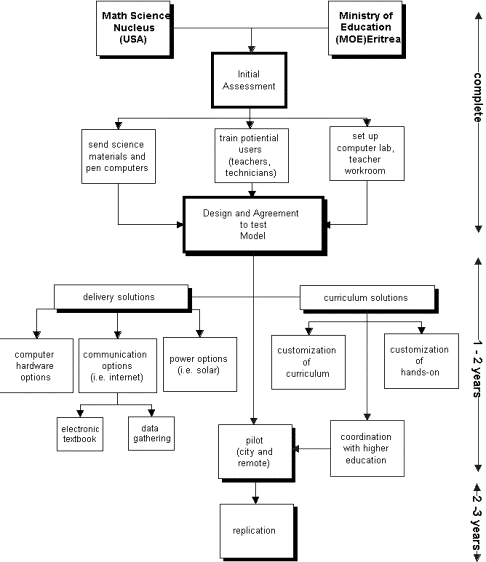
Developing a Model
The Eritrean President Isaias Afwerki, the Minister of Education, and the President of the University of Asmara met with the Math/Science Nucleus in Asmara in May of 2001. It was agreed that they shared a common vision for educating Eritrean children. The Math/Science Nucleus proceeded to do an evaluation of the educational system that showed there was a need to upgrade the content of the entire science curriculum. Most teachers wanted up-to-date content and more hands-on teaching opportunities. While science textbooks were available for lower grade students, they lacked continuity into the upper grades and were outdated with few applied concepts.

Figure 3
From its prior work in the United States, the Math Science Nucleus realized the need to insure that administrators and educators can act and respond as a team to reform any educational system. With these concerns in mind, in subsequent visits, the Math Science Nucleus verified its ability to train Eritrean computer personnel who could support an electronic implementation of the curriculum. Together with local science experts it customized portions of the I. Science MaTe curriculum in one of the nine languages used in the school system. A networked computer lab (20 computers donated by DANIDA[1]), that simulated Internet usage, was set up at the Asmara Teacher Training Institute (ATTI). Math Science Nucleus successfully trained 20 professors, teachers, and curriculum writers in the use of the electronic version of the I. Science MaTe program and the retrieval of electronically stored information via intranet, Internet, and removable hard drive formats. The computer lab is now used to train 600 teachers per year at ATTI who are instructed by two teachers from the United Kingdom. Math/Science Nucleus also created a teacher workroom at ATTI and stocked it with materials that were shipped from the United States. Pen computers were purchased and teachers were trained on how to use the equipment.
Convinced that the progress justified proceeding, the Minister of Education asked the Math Science Nucleus to develop a plan of action (figure 3) to deliver the customized science curriculum with new technologies. To help the implementation of the project, the Minister of Education named a full time Eritrean coordinator to be responsible for the program.
The project calls for a three-year program undertaken jointly by an Eritrean Project Team and a Math Science Nucleus Project Team. They will develop and implement a model solution to test the basic hypothesis that ing new technology and an innovative science curriculum can increase literacy. There will be an initial one year pilot test at the primary school level. The initial year will be followed by two years of replication testing and implementation in which secondary school implementation and testing is phased into the project.
The Eritrean Project Team has primary responsibility for implementation of the program on site in Eritrea. The Math Science Nucleus Project Team, acting, as consultants to the Eritrean Project Team, has primary responsibility for the specification of the technology delivery solution. The teams will jointly develop the curriculum solutions and the science methods courses.
[1] DANIDA is an acronym for the Danish Agency for Development Assistance that has overseen the bilateral agreements for Danish development assistance to Eritrea.